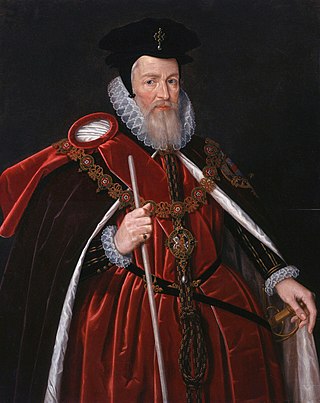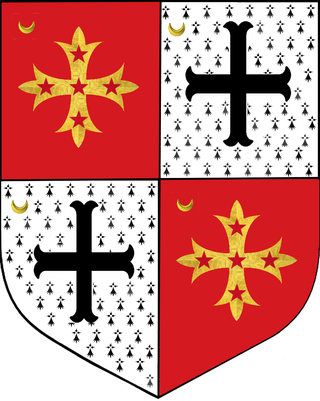Related Research Articles

Sir Francis Walsingham was principal secretary to Queen Elizabeth I of England from 20 December 1573 until his death and is popularly remembered as her "spymaster".

William Cecil, 1st Baron Burghley was an English statesman, the chief adviser of Queen Elizabeth I for most of her reign, twice Secretary of State and Lord High Treasurer from 1572. In his description in the Encyclopædia Britannica Eleventh Edition, A.F. Pollard wrote, "From 1558 for forty years the biography of Cecil is almost indistinguishable from that of Elizabeth and from the history of England."

Lady Arbella Stuart was an English noblewoman who was considered a possible successor to Queen Elizabeth I of England. During the reign of King James VI and I, she married William Seymour, 2nd Duke of Somerset, another claimant to the English throne, in secret. King James imprisoned William Seymour and placed her under house arrest. When she and her husband tried to escape England, she was captured and imprisoned in the Tower of London, where she died at age 39.

Sir Henry Sidney was an English soldier, politician and Lord Deputy of Ireland.

Edward Somerset, 4th Earl of Worcester, KG, Earl Marshal was an English aristocrat. He was an important advisor to King James I, serving as Lord Privy Seal.

Sir Ralph Sadler or Sadleir PC, Knight banneret was an English statesman, who served Henry VIII as Privy Councillor, Secretary of State and ambassador to Scotland. Sadler went on to serve Edward VI. Having signed the device settling the crown on Jane Grey in 1553, he was obliged to retire to his estates during the reign of Mary I. Sadler was restored to royal favour during the reign of Elizabeth I, serving as a Privy Councillor and once again participating in Anglo-Scottish diplomacy. He was appointed Chancellor of the Duchy of Lancaster in May 1568.
William Davison was an English diplomat and secretary to Queen Elizabeth I. As a Secretary of some influence, he was active in forging alliances with England's Protestant friends in Holland and Scotland to prevent war with France. He was involved in the 1587 execution of Mary, Queen of Scots, and was made a scapegoat for this event.

Thomas Stucley was an English mercenary who fought in France, Ireland and at the Battle of Lepanto before being killed at the Battle of Alcácer Quibir in 1578. He was a Catholic recusant and a rebel against the Protestant Elizabeth I.

Sir William Wade was an English statesman and diplomat, and Lieutenant of the Tower of London.

Thomas Wentworth, 2nd Baron Wentworth was an English peer, courtier, administrator and military commander during the reigns of Edward VI, Mary I and Elizabeth I. His reputation suffered through the surrender of Calais in 1558, which occurred under his command.

Sir William Drury was an English statesman and soldier.

Sir Francis Knollys, KG of Rotherfield Greys, Oxfordshire was an English courtier in the service of Henry VIII, Edward VI and Elizabeth I, and was a Member of Parliament for a number of constituencies.
Sir Henry Killigrew was a diplomat and an ambassador for the Kingdom of England in the sixteenth century. He was several times employed by Elizabeth I in Scottish affairs and served as one of the English appointees to the Council of State of the Netherlands in the United Provinces in 1586 and 1587–1589. He served as a Member of Parliament for Newport & Launceston in 1553, for Saltash in 1563, and for Truro in 1571–2.

Edward Wotton, 1st Baron Wotton (1548–1626) was an English diplomat and administrator. From 1612 to 1613, he served as a Lord of the Treasury. Wotton was Treasurer of the Household from 1616 to 1618, and also served as Lord Lieutenant of Kent from 1604 until 1620.
Sir Christopher Nugent, 6th Baron Delvin (1544–1602) was an Irish nobleman and writer. He was arrested on suspicion of treason against Queen Elizabeth I of England, and died while in confinement before his trial had taken place.

Susan Herbert, Countess of Montgomery, was an English court office holder. She served as lady-in-waiting to the queen consort of England and Scotland, Anne of Denmark. She was the youngest daughter of Elizabethan courtier, and poet Edward de Vere, 17th Earl of Oxford.
Sir Walter Buckler was a diplomat, chamberlain of the household to Lady Elizabeth, later Queen Elizabeth I, and private secretary to Catherine Parr, the sixth wife of King Henry VIII.

Sir Andrew Corbet was an English Protestant politician of the mid-Tudor and early Elizabethan periods: a member of the powerful Council in the Marches of Wales for a quarter of a century. Drawn from the landed gentry of Shropshire and Buckinghamshire, he was twice a member of the Parliament of England for Shropshire.

Sir Henry Ughtred or Oughtred was a merchant and shipbuilder during the reign of Elizabeth I. One of his ships, the Leicester sailed with Sir Francis Drake against the Spanish Armada. He was elected MP for the seat of Marlborough in 1584 and of Great Bedwyn in 1589. A wealthy landowner, Ughtred played an active role in the Plantations of Ireland and was knighted by the Lord Deputy in 1593. He was the son of Sir Anthony Ughtred and Elizabeth Seymour, sister to Jane, the third wife of Henry VIII. Sometime after 1557 he married Elizabeth, widow of Sir William Courtenay and daughter of John Paulet, 2nd Marquess of Winchester.
Conn McCalvagh O'Donnell was a member of the O'Donnell dynasty of Donegal. At various points in his turbulent career, Conn either opposed or allied himself with the English Crown, Shane O'Neill or Turlough Luineach O'Neill, as the situation and his personal advantage dictated in order to pursue his rivalry with his father's younger brother, Hugh mac Manus O'Donnell.
References
- Attribution
 This article incorporates text from a publication now in the public domain : Goodwin, Gordon (1894). "Molyneux, Edmund (fl.1587)". In Lee, Sidney (ed.). Dictionary of National Biography . Vol. 38. London: Smith, Elder & Co. p. 133–134. Endnotes:
This article incorporates text from a publication now in the public domain : Goodwin, Gordon (1894). "Molyneux, Edmund (fl.1587)". In Lee, Sidney (ed.). Dictionary of National Biography . Vol. 38. London: Smith, Elder & Co. p. 133–134. Endnotes:- Calendar of the Carew Manuscripts Preserved in the Archiepiscopal Library at Lambeth, Volume 1, 1515–74, pp. 401, 402;
- Thomas Tanner, Bibliotheca Britannico-Hibernica, p. 530;
- Holinshed's Chronicles, ed. 1587, iii. 1590 ;
- Calendar of State Papers, Domestic. Edward VI, Mary, Elizabeth, and James I, Volume 1, 1547–80, p. 195;
- Arthur Collins, Letters and Memorials of State in the Reigns of Queen Mary, Queen Elizabeth, i. 66, 210, 227, 239, 240, 296.